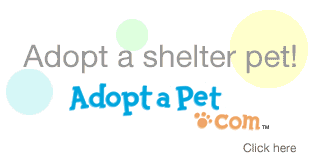Here's a great article that I thought I would pass on...hope you find it interesting! –Kim
An Early Warning System

By: Marc Goldberg, CDT
Guarding is an instinctual behavior for your dog. It's useful when he warns strangers who intrude on his (and your) territory. One of the earliest benefits dogs provided to man was to serve as an early warning intruder alert system.
Territoriality is, simply stated, guarding space. It is the dog's way of saying "This space has value and it belongs to my pack and me." In fact, dogs guard all sorts of things: some tangible, such as food or toys, others intangible such as space.
When they guard these items from outsiders, it can be helpful. I leave my home knowing my dog will be alert to an inappropriate intrusion. Dogs also guard tangibles and intangibles from one another. You shouldn't expect to see a submissive dog take a bone or scrap from the "alpha" or dominant dog. Should she try, she'll face a swift correction. But that's rarely necessary because in the structure of the dog pack, it is clearly understood who is entitled to what and when.
But what happens when that clear understanding is lacking between a dog and members of his human pack? The results can be a disaster…a dog who guards something against his very owners.
In this article, we'll concentrate on space-guarding behavior. In the dog pack, if the dominant dog wants to walk from point A to point B, he will do it even if he has to nudge a lesser dog out of his way. If the more submissive dog protests, what he is actually doing is challenging the authority of his leader by trying to guard the space he occupies.
The same event may transpire in our homes. Your dog helps himself to a place on the sofa. You either sit down next to him or try to take his collar to pull him off. Your own dog growls or snaps at you. She's guarding space. Moreover, she's stating in dog language that she believes she is dominant to you.
You need to open a cabinet and the dog is blocking your way. You take his collar to move him, and he growls or bites. The same thing may occur when you want to push the dog out a door, pass him in a narrow hallway, or get too close to him laying in his favorite spot.
In many households, the human occupants never realize that their dog is guarding space until the dog becomes completely out of control. In fact, we often excuse the behavior. That's because, too often, people apply human standards to canine behavior. Among our species it is impolite to pull someone out of a chair or shoulder them aside when you need something. So, if the dog growls when you sit by him on the couch, many people wrongly think the dog is just being grumpy, or that he was too comfortable to be disturbed.
Sometimes, adults may even chastise children for being "impolite" to a dog for sitting next to her on furniture, or for wanting to remove the dog from her place. People subconsciously try to accept these problems as "quirks" of the dog. Many owners try to just work around the issue by not disturbing the dog in whatever circumstance may be causing the dog to guard.
Unfortunately, this sends precisely the wrong message to the dog. Humoring him confirms that he is dominant, and is, therefore, entitled to guard more and more space. That's why guarding behavior escalates for many dogs. Often, I hear from owners who's dog began to growl at them under very limited conditions, say when being pulled off the sofa. But eventually, the behavior escalates to the point where the dog growls when they even get near him on the sofa.
The owner thinks the dog is getting worse. The dog simply thinks she's getting stronger. For some dogs, dominance is a self-rewarding behavior. You want to remove her from the couch. She growls; you back off. In the dog's mind, the behavior works. So eventually she growls when you even look at her on the couch. "They just don't seem to get it," the dog is thinking. "I'll have to warn them earlier."
This can become very problematic for some pet owners, particularly those with young children in the house. Tiny kids often don't realize that they're "not supposed to bother the dog." They just figure they have liberty to safely toddle wherever their little legs will take them. And if you ask me, they should have that right.
Older children must be taught to respect dogs. And younger children must be observed very carefully when they interact with a dog, to be sure they do not accidentally pinch him, for example. But no one can expect a two-year-old child to understand she should avoid Rover when he's laying on the sofa.

Willy is a three-year-old German Short Hair Pointer. His owner, Linda, called me very concerned. Willy had been growling at her baby every time the child approached him in his dog bed. Sometimes, Willy would climb on the couch, and he would also growl at the baby on those occasions. Apparently, this behavior had been going on for over a month. And just recently, the dog had growled at Linda when she sat near him on the couch. Linda was very confused because this entire set of behaviors was only about a month old, but it was getting worse fast.
"Did your baby start walking about a month ago?" I asked her. The answer was yes. That made it all clear to me. Willy always felt Linda was dominant to him. So he never growled at her before. But when the baby started walking, this impudent little human would intrude on his space, and Willy did believe himself dominant to the baby.
Not understanding the behavior, Linda had spent an entire month showing Willy how dominant he was by not correcting him and not letting the baby disturb him when he was comfortable. The unintended message to Willy was that he was more dominant than he had originally thought. That's why he began to guard space from Linda too.
While not all dogs progress from growling to snapping, or from air snapping to contact biting, that does happen with some dogs. And it's tragic, because it usually doesn't need to reach that point. Left untreated, most dogs who effectively guard space will eventually scare or hurt their owners enough to be removed from their homes, or be put down.
Willy became a client of the Chicagoland Boarding School for Dogs. In the time he spent with us, we used our Forcefree Method to show him that space was not a resource he should guard from his human family.
We taught Willy a series of exercises using a vibrating training collar, delivering a series of low level taps. The vibration, while not at all painful, was attention getting. (Before we put the collar on Willy, we let Linda feel the the collar on her hand, so she understood they were not painful. Linda described the feeling as a mild tickle.) During the initial phase of training, our goal was to teach Willy that, when he felt the taps, he could stop them by altering a behavior.
We started out with leash pulling, showing him that pulling on a tight leash turned on the tapping sensation, and that walking nicely on a loose leash turned them off. Then we went to the sit-stay. We showed Willy that getting up when he was supposed to be sitting turned on taps that he could turn off instantly by re-sitting himself.
The reason we didn't go right to the space guarding issue was simple. We didn't want to overwhelm the dog by immediately training for the most difficult behavior first. Also the guarding behavior is very specific to the family. They might be tough to reproduce without his sofa, his baby and his owner.

But when Willy understood that he could stop collar taps by altering a behavior, we were ready to confront the real issue, the guarding of space. By this point in the training, we had established a bond of trust and affection with Willy. That was critical because now we were teaching him to yield his personal space to us under the pressure of the taps.
In short, by sometimes invading Willy's personal space, while tapping, we showed him that he could turn off the tapping, as usual, by giving us a desired behavior…in this case, moving out of the way. Starting on leash, we held the dog close to our body, literally turning into him, and tapped as we moved through his space. Using a combination of leash pressure and body movement, we moved Willy out of the way. The second he began to yield his space, the taps stopped.
Willy began to understand very quickly. Space wasn't worth guarding anymore. In fact, each time we asked him to give up space, he became very willing to do so at once. After all, as far as he knew, any space that we requested became slightly annoying anyway.
We brought this dog home at the conclusion of our ten day program, reoriented him to his family and his environment, and transferred the behavior modification techniques to his owner over the course of two hours. Then we left.
Linda called two days later. She reported that Willy was leaving his dog bed as soon as the baby approached. We were happy with this report, but Linda was concerned. She wanted the dog and the baby to be friends and she was worried that the dog was now "fleeing" from the baby.
We explained that this was progress given that the dog had modified a major behavior and was now yielding space, rather than guarding it. We advised her to give it some more time to see if the dog would eventually find pleasure in sharing space, time and bonding with the baby in his new submissive role. We did warn Linda that not all dogs bond with all people, but that it was still a distinct possibility.
Two weeks later Linda called again, and she was very happy. She found Willy and the baby curled up together in the dog's bed. Apparently, Willy had calmed down enough to realize that while he was no longer able to guard space, there was a wonderful pleasure in sharing it.
Trust is something that grows over time, and with experience. Every day that passes as Willy continues to show the right reaction is one more day in which the trust between him and his family grows. Willy has been home for several months now, and all the reports are good news.
Here is a dog who was at severe risk for re-homing and possibly might have injured a child, curled up in bed with his little master.
 The author, Marc Goldberg, is a dog trainer specializing in the rehabilitation of difficult dogs and improving relationships. He is Vice President of the International Association of Canine Professionals (IACP) and Editor of SafeHands Journal. The author also educates professional dog trainers in his techniques. Visit him on the Web at http://www.chicagodogtrainer.com or http://www.dogtraininginchicago.com.
The author, Marc Goldberg, is a dog trainer specializing in the rehabilitation of difficult dogs and improving relationships. He is Vice President of the International Association of Canine Professionals (IACP) and Editor of SafeHands Journal. The author also educates professional dog trainers in his techniques. Visit him on the Web at http://www.chicagodogtrainer.com or http://www.dogtraininginchicago.com.




































